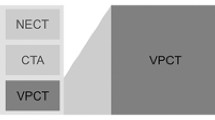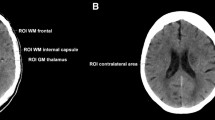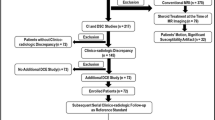Abstract
Purpose
To assess whether 320-section low-dose dynamic volume computed tomography (320-LDVCT) with adaptive iterative dose reduction (AIDR) adds value to 3-T MRI for the preoperative evaluation of brain tumors.
Methods
The study population was comprised of 16 consecutive patients with brain tumors who, in addition to preoperative 3-T MRI, underwent 320-LDVCT with AIDR. Two radiologists independently evaluated the CT and MRI studies; one measured the relative cerebral blood volume (rCBV) in the tumor and contralateral brain on CT and MR perfusion maps. Interobserver agreement was assessed by κ statistics.
Results
In 3 of 16 patients (19 %), 320-LDVCT added diagnostic value to 3-T MRI studies with respect to the visualization of feeders (κ = 0.77), and in 12 (75 %) it helped the delineation of venous structures (κ = 0.71) and the relationship between the tumor and adjacent vessels (κ = 0.85). The average standardized rCBV value was 12.2 ± 2.40 (range 0.7–36.6) on MR and 8.80 ± 2.77 (range 0.8–38.0) on CT perfusion studies; the correlation between these values was very strong (r = 0.92, p < 0.0001). According to the neurosurgeons, 320-LDVCT added helpful information for surgery in 4 patients (25 %).
Conclusion
The 320-LDVCT can add value to 3-T MRI for the tumor feeders and relationship between the tumor and adjacent vessels.



Similar content being viewed by others
Abbreviations
- AIDR:
-
Adaptive iterative dose reduction
- 320-LDVCT:
-
320-Section low-dose dynamic volume CT
- rCBV:
-
Relative cerebral blood volume
- MRI:
-
Magnetic resonance imaging
References
Essig M, Anzalone N, Combs SE, Dorfler A, Lee SK, Picozzi P, et al. MR imaging of neoplastic central nervous system lesions: review and recommendations for current practice. AJNR Am J Neuroradiol. 2012;33:803–17.
Uetani H, Akter M, Hirai T, Shigematsu Y, Kitajima M, Kai Y, et al. Can 3 T MR angiography replace DSA for the identification of arteries feeding intracranial meningiomas? AJNR Am J Neuroradiol. 2013;34:765–72.
Murayama K, Katada K, Nakane M, Toyama H, Anno H, Hayakawa M, et al. Whole-brain perfusion CT performed with a prototype 256-detector row CT system: initial experience. Radiology. 2009;250:202–11.
Hayakawa M, Maeda S, Sadato A, Tanaka T, Kaito T, Hattori N, et al. Detection of pulsation in ruptured and unruptured cerebral aneurysms by electrocardiographically gated 3-dimensional computed tomographic angiography with a 320-row area detector computed tomography and evaluation of its clinical usefulness. Neurosurgery. 2011;69:843–51 (discussion 51).
Willems PW, Brouwer PA, Barfett JJ, terBrugge KG, Krings T. Detection and classification of cranial dural arteriovenous fistulas using 4D-CT angiography: initial experience. AJNR Am J Neuroradiol. 2011;32:49–53.
Kim DJ, Krings T. Whole-brain perfusion CT patterns of brain arteriovenous malformations: a pilot study in 18 patients. AJNR Am J Neuroradiol. 2011;32:2061–6.
Willems PW, Taeshineetanakul P, Schenk B, Brouwer PA, Terbrugge KG, Krings T. The use of 4D-CTA in the diagnostic work-up of brain arteriovenous malformations. Neuroradiology. 2012;54:123–31.
Chen W, Xing W, Peng Y, He Z, Wang C, Wang Q. Cerebral aneurysms: accuracy of 320-detector row nonsubtracted and subtracted volumetric CT angiography for diagnosis. Radiology. 2013;269:841–9.
Kidoh M, Hirai T, Oda S, Utsunomiya D, Kawano T, Yano S, et al. Can CT angiography reconstructed from CT perfusion source data on a 320-section volume CT scanner replace conventional CT angiography for the evaluation of intracranial arteries? Jpn J Radiol. 2015;33:353–9.
Funama Y, Utsunomiya D, Taguchi K, Oda S, Shimonobo T, Yamashita Y. Automatic exposure control at single- and dual-heartbeat CTCA on a 320-MDCT volume scanner: effect of heart rate, exposure phase window setting, and reconstruction algorithm. Phys Med. 2014;30:385–90.
Nitta N, Ikeda M, Sonoda A, Nagatani Y, Ohta S, Takahashi M, et al. Images acquired using 320-MDCT with adaptive iterative dose reduction with wide-volume acquisition: visual evaluation of image quality by 10 radiologists using an abdominal phantom. AJR Am J Roentgenol. 2014;202:2–12.
Tabuchi S, Nakajima S. Usefulness of 320-row area detector computed tomography for the diagnosis of cystic falx meningioma. Case Rep Oncol. 2013;6:362–6.
Chen T, Guo D, Fang Z, Zhong W, Zhao J, Jiang Y. Preliminary study of whole-brain CT perfusion imaging in patients with intracranial tumours adjacent to large blood vessels. Clin Radiol. 2014;69:e25–32.
Rosen BR, Belliveau JW, Buchbinder BR, McKinstry RC, Porkka LM, Kennedy DN, et al. Contrast agents and cerebral hemodynamics. Magn Reson Med. 1991;19:285–92.
Mert A, Buehler K, Sutherland GR, Tomanek B, Widhalm G, Kasprian G, et al. Brain tumor surgery with 3-dimensional surface navigation. Neurosurgery. 2012;71:ons286–94 (discussion ons94-5).
Nabavi DG, Cenic A, Craen RA, Gelb AW, Bennett JD, Kozak R, et al. CT assessment of cerebral perfusion: experimental validation and initial clinical experience. Radiology. 1999;213:141–9.
Eastwood JD, Provenzale JM. Cerebral blood flow, blood volume, and vascular permeability of cerebral glioma assessed with dynamic CT perfusion imaging. Neuroradiology. 2003;45:373–6.
Ellika SK, Jain R, Patel SC, Scarpace L, Schultz LR, Rock JP, et al. Role of perfusion CT in glioma grading and comparison with conventional MR imaging features. AJNR Am J Neuroradiol. 2007;28:1981–7.
Nishimura S, Hirai T, Shigematsu Y, Kitajima M, Morioka M, Kai Y, et al. Evaluation of brain and head and neck tumors with 4D contrast-enhanced MR angiography at 3T. AJNR Am J Neuroradiol. 2012;33:445–8.
Author information
Authors and Affiliations
Corresponding author
Ethics declarations
Conflict of interest
E. H, T. H, H. N, M. K, M. A, Y. I, M. K, S. O, D. U, T. N, Y. Y: None.
Financial disclosure
E. H, T. H, H. N, M. K, M. A, Y. I, M. K, S. O, D. U, T. N, Y. Y: None.
We declare that all human and animal studies have been approved by the Kumamoto University ethics committee and have therefore been performed in accordance with the ethical standards laid down in the 1964 Declaration of Helsinki and its later amendments. We declare that all patients gave informed consent prior to inclusion in this study.
About this article
Cite this article
Hayashida, E., Hirai, T., Nakamura, H. et al. Additive value of 320-section low-dose dynamic volume CT in relation to 3-T MRI for the preoperative evaluation of brain tumors. Jpn J Radiol 34, 691–699 (2016). https://doi.org/10.1007/s11604-016-0576-9
Received:
Accepted:
Published:
Issue Date:
DOI: https://doi.org/10.1007/s11604-016-0576-9




